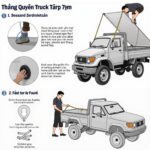Tie rod end failure in trucks is a serious issue that can compromise vehicle control and safety. This article provides an overview of truck tie rod ends, the causes of failure, warning signs, and how to address this problem.
The tie rod end, a crucial component in a truck’s steering system, connects the steering linkage to the wheel hub assembly. It allows the wheels to turn in response to steering wheel input. A broken tie rod end severely impacts the vehicle’s steering capability.
Causes of Truck Tie Rod End Failure
Several factors can lead to tie rod end failure in trucks:
- Hard Impacts: Accidents or strong collisions can deform or break tie rod ends.
- Overloading: Consistently carrying excessive weight puts significant stress on the steering system, increasing the risk of tie rod end failure.
- Rough Roads: Frequent driving on bumpy, pothole-filled roads subjects tie rod ends to continuous high-intensity stress, making them prone to damage.
- Improper Installation: Incorrect installation of tie rod ends is a common cause of premature failure.
- Poor Quality Tie Rod Ends: Using low-quality, non-genuine tie rod ends will lead to rapid wear and breakage.
- Poor Maintenance: Neglecting regular inspection, maintenance, and lubrication of tie rod ends reduces their lifespan.
Signs of Truck Tie Rod End Failure
Early detection of tie rod end failure is crucial for timely intervention, preventing serious consequences. Key warning signs include:
- Steering Wheel Vibration: Especially noticeable at high speeds or on uneven road surfaces.
- Unusual Steering System Noises: This could be creaking, squeaking, or clunking sounds when steering.
- Vehicle Pulling to One Side: The truck tends to drift or pull to one side while driving.
- Uneven Tire Wear: Tie rod end failure can cause uneven tire wear, reducing tire lifespan.
- Misaligned Wheel Angles: This can be detected during a wheel alignment service.
How to Fix Truck Tie Rod End Failure
If you suspect a broken tie rod end, immediately take your truck to a reputable garage for inspection and repair. The typical solution is to replace the faulty tie rod end with a new one. It’s essential to use genuine, high-quality tie rod ends and have them installed by experienced technicians.
Conclusion
Truck tie rod end failure is a dangerous issue that directly affects driving safety. Understanding the causes, signs, and solutions empowers you to proactively maintain your vehicle and address problems promptly, ensuring safety for yourself and other road users. Regularly inspect and maintain your truck’s steering system to prevent this type of failure.

